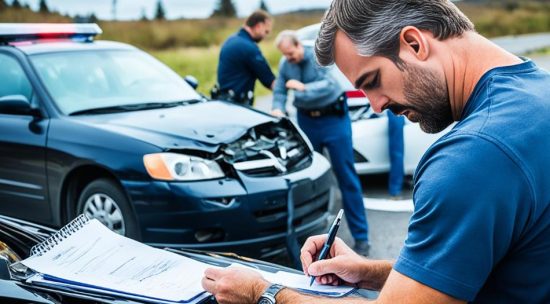
You lend your car to a friend or family member who doesn’t appear on your insurance policy. Everything seems fine until you receive a call informing you that the worst has happened – your car has been wrecked. Panic sets in as you wonder about the consequences and who should be held responsible. Will the damages be covered by insurance? Can you be held liable for the accident?
It’s a scenario that can leave you feeling perplexed, caught between the desire to be helpful and the potential repercussions of lending your car to someone without insurance coverage. Understanding the implications of such a situation is crucial in protecting yourself and your assets.
We will delve into the question: What happens if someone wrecks your car and they aren’t on your insurance? We will explore liability concerns, the impact on insurance coverage, and what steps you should take if you find yourself in this unfortunate situation.
Understanding Auto Insurance Coverage and Permissive Use

Auto insurance coverage and permissive use are closely linked when it comes to protecting your vehicle and yourself. Permissive use refers to giving someone who is not on your insurance policy permission to drive your car. Most auto insurance policies provide some level of coverage for permissive use. This coverage ensures that both the driver and the vehicle are protected in the event of an accident.
Defining Permissive Use in Auto Insurance Terms
Permissive use is when you allow someone who is not listed on your insurance policy to drive your car with your permission. Examples of permissive use can include lending your car to a family member or a friend for a short period. It’s important to note that permissive use typically applies to occasional drivers rather than regular drivers of your vehicle.
How Insurance Companies View Permissive versus Non-Permissive Use?
Insurance companies differentiate between permissive use and non-permissive use, which can impact your coverage in the event of an accident. Permissive use is generally covered by your auto insurance policy, whereas non-permissive use refers to someone driving your car without your permission. Non-permissive use is often excluded from coverage, which means that insurance claims may be denied if the driver did not have your consent to use your vehicle.
Understanding the distinction between permissive and non-permissive use is important to ensure that you have the right coverage in place. It’s crucial to review your insurance policy to understand the terms and conditions related to permissive use and any exclusions that may apply.
| Permissive Use | Non-Permissive Use |
|---|---|
| Allows someone not on your insurance policy to drive your car with your permission | Refers to someone driving your car without your consent |
| Generally covered by your auto insurance policy | May be excluded from coverage |
| Provides protection for both the driver and the vehicle | May result in denied insurance claims |
Liability Concerns When an Uninsured Driver is Involved in an Accident
When an uninsured driver is involved in an accident with your car, it can lead to significant liability concerns. It’s crucial to understand that in these situations, insurance coverage follows the car, not the driver. This means that even if the uninsured driver is at fault, your insurance company may still be responsible for covering the damages. However, there is a limitation to this coverage. If the damages resulting from the accident exceed your policy’s coverage limits, you may find yourself facing substantial out-of-pocket expenses. It’s essential to thoroughly review your policy and understand the coverage limits to ensure you are prepared for such circumstances.
Do Immediately After Someone Else Crashes Your Car?
Discovering that someone else has crashed your car can be a stressful situation. To ensure a smooth claims process, it is crucial to take immediate action. Follow these steps to protect yourself, gather necessary information, and report the accident to your insurance company:
- Ensure Safety: Check for injuries and move to a safe location if possible. If anyone requires medical attention, call emergency services.
- Gather Information: Collect the contact and insurance details of the other driver(s) involved. Include their name, phone number, address, driver’s license number, and insurance provider.
- Document the Accident: Take photos of the accident scene, including vehicle damage, skid marks, and road conditions. Write down the date, time, location, and a brief description of what happened.
- Report to the Police: Depending on your location and the severity of the accident, you may need to report it to the police. Contact your local authorities for guidance.
- Notify Your Insurance Company: Contact your insurance company as soon as possible to report the accident. Provide them with accurate and detailed information about the incident.
- Follow Instructions: Your insurance company will guide you through the claims process. Follow their instructions and provide any additional information or documentation they require.
Managing Policy Claims and Potential Premium Increases
When dealing with an accident involving someone who isn’t on your insurance, it’s crucial to understand the process of filing a claim with your insurance provider. Filing an insurance claim is the first step in receiving compensation for the damages to your vehicle. By following the steps outlined below, you can navigate the claims process with confidence:
Steps on Filing a Claim with Your Insurance Provider
- Contact your insurance provider as soon as possible after the accident. It’s important to report the incident promptly to initiate the claims process.
- Provide accurate and detailed information about the accident to your insurance provider. This includes the date, time, location, and a description of the events leading up to the accident.
- Cooperate fully with your insurance provider’s investigation. They may require additional information or documentation to assess the extent of the damages and determine liability.
- Follow any instructions or requirements provided by your insurance provider, such as obtaining repair estimates, submitting photographs of the damages, or attending a vehicle inspection.
- Keep documentation of all communication and correspondence with your insurance provider, including claim numbers, names of representatives, and copies of any written or digital communication.
- Work with your insurance provider to coordinate the repair process. They may have preferred repair shops or specific procedures that need to be followed to ensure smooth and efficient repairs.
- Keep records of all expenses related to the accident, such as towing fees, rental car costs, and any out-of-pocket expenses for which you expect reimbursement.
- Be patient throughout the process. Claims can take time to resolve, especially if there are complicated circumstances or disputes with the other party involved.
Following these steps will help streamline the claims process and increase the likelihood of a successful outcome.
How Premiums May Increase as a Result of the Incident
It’s important to understand that an accident involving someone who isn’t on your insurance may impact your insurance premiums. Insurance providers consider various factors when determining premiums, and accidents can be one of them. The impact on your premiums will depend on factors such as:
- Severity of the accident: The extent of the damages and injuries resulting from the accident can influence premium increases.
- At-fault determination: If you are found to be at fault for the accident, your premiums are more likely to increase.
- Previous driving history: Insurance providers often take into account your driving record, including any previous accidents or traffic violations, when determining premiums.
- Claims history: If you’ve had previous claims, whether related or unrelated to the current accident, it can impact your premiums.
- Insurance provider’s policies: Each insurance provider has its own policies and guidelines regarding premium increases after accidents. It’s essential to review your policy or speak with your insurance representative to understand how your premiums may be affected.
| Accident Severity | Premium Increase |
|---|---|
| Minor damages | Small to moderate increase |
| Significant damages and injuries | Substantial increase |
| At-fault determination | Likely increase |
When You Should Consider Adding Another Driver to Your Insurance Policy
If you frequently have other drivers using your car, it may be time to consider adding them to your insurance policy. By adding drivers who regularly operate your vehicle, you can enjoy additional coverage and protection in the event of an accident. Furthermore, this ensures your insurance company accurately assesses the risk involved, allowing them to determine the appropriate premium for your policy.

There are several circumstances in which adding another driver to your insurance policy becomes essential. For example, if you have a family member who frequently borrows your car or a roommate who regularly uses it for commuting, it’s crucial to have them listed as a covered driver on your policy. By doing so, you can ensure they have adequate protection and minimize liability risks. Adding drivers to your policy offers numerous benefits. It provides these drivers with the necessary coverage in case of an accident, protecting them from costly expenses. Secondly, adding drivers can help you distribute the risk associated with insuring your vehicle, potentially leading to more affordable insurance premiums.
The Impact of ‘At-Fault’ Accidents on Insurance Coverage
Understanding the impact of ‘at-fault’ accidents on insurance coverage is crucial. In the unfortunate event that the borrowed driver is at fault in an accident, it can have consequences for both primary and secondary coverage.
Understanding At-Fault Accidents and Secondary Coverage
An ‘at-fault’ accident refers to a situation where the driver who caused the accident is deemed responsible for the damages. When it comes to insurance coverage, the driver at fault is typically liable for the resulting costs.
However, in the context of lending your car to someone else, the situation becomes more complex. If you lend your car to a friend or family member who causes an accident, their insurance might be primary coverage for the damages. In this case, their insurance policy would be the first line of defense to cover the costs.
If the damages from the accident exceed the primary coverage limits, secondary coverage comes into play. Secondary coverage refers to additional insurance that can provide protection when the primary coverage is insufficient. It can be in the form of an umbrella policy or a secondary auto insurance policy. Secondary coverage helps bridge the gap between the primary coverage limits and the total cost of the damages.
Financial Implications When the Borrowed Driver is At-Fault
When the borrowed driver is at fault in an accident, there can be financial implications for both the driver and the car owner. If the borrowed driver has their insurance, their policy should cover the damages up to their coverage limits.
However, if the damages exceed their coverage limits, the car owner’s secondary coverage, if available, may come into play to cover the remaining costs. It’s important to note that secondary coverage is not always automatic, and the car owner may need to have specific insurance in place to qualify for this additional protection.
Non-Permissive Use: How Unauthorized Use Affects Your Insurance
Non-permissive use refers to someone driving your car without your permission. Unauthorized use can significantly impact your insurance coverage, leading to potential claim denials and complications.
When someone operates your vehicle without your permission, it creates a challenging situation for insurance coverage. In the event of an accident or damage caused by the unauthorized user, your insurance company may deny your claim or only provide limited coverage. This can leave you personally liable for the costs associated with repairs, medical bills, and other expenses.
Insurance providers typically require policyholders to give explicit consent for others to drive their vehicles. Non-permissive use violates this requirement, and insurance companies may consider it a breach of your policy terms. They may argue that by allowing someone to drive your car without permission, you have acted negligently and knowingly increased the risk of an accident.
To safeguard against non-permissive use, it’s essential to:
- Keep your keys secure: Store your car keys in a safe place, and don’t leave them out where they can be easily accessed by unauthorized individuals.
- Communicate with family and friends: Make sure your family members and friends understand that only authorized drivers are permitted to use your car and emphasize the importance of obtaining their own insurance coverage.
- Be cautious with loaning your car: Before lending your vehicle to someone, ensure they are listed as a covered driver on your insurance policy or have their own insurance coverage.
- Consider additional security measures: Installing an alarm system or a GPS tracking device can provide an extra layer of protection against unauthorized use.
By taking these preventive measures, you can minimize the risk of non-permissive use and help protect your insurance coverage.
Now that we’ve explored the impact of non-permissive use on your insurance, it’s important to understand the common reasons for insurance claim denials. In the next section, we will discuss these reasons in detail and provide preventive measures to ensure a successful claims process.
Insurance Claim Denials: Scenarios and Preventive Measures

An insurance claim denial can be a frustrating experience, but understanding the common reasons for these denials can help you navigate the claims process more effectively. By taking preventive measures to mitigate the risk of claim denials, you can increase the likelihood of a successful claim.
Common Reasons for Insurance Claim Denials
Insurance claim denials can occur due to lack of coverage, delayed reporting, inaccurate or incomplete information, pre-existing damage, and policy exclusions. To avoid potential denials, understand your policy’s coverage limits and exclusions, report incidents promptly, provide accurate information, document any pre-existing damage, and familiarize yourself with policy exclusions.
Preventing Unauthorized Use and Its Complications on Claims
To prevent unauthorized use of your vehicle and minimize complications in the claims process, consider the following preventive measures:
- Keep your keys secure: Safeguard your car keys to prevent unauthorized individuals from accessing and using your vehicle without your knowledge or permission.
- Limit vehicle access: Only lend your car to trustworthy individuals who are properly licensed and insured. Restricting access to your vehicle reduces the risk of unauthorized use.
- Implement driver screening: Before allowing someone to borrow your car, conduct background checks to ensure they have a good driving record and are responsible drivers.
- Install anti-theft devices: Equipping your vehicle with anti-theft devices such as alarms and immobilizers can deter unauthorized use and enhance its security.
- Review your policy: Regularly review your insurance policy to ensure it adequately covers unauthorized use and take the necessary steps to update your coverage if needed.
By understanding the common reasons for claim denials and implementing preventive measures against unauthorized use, you can protect yourself and your insurance coverage. Stay proactive in managing your policy and take the necessary precautions to prevent claim denials.
Risks of Allowing Uninsured Drivers to Operate Your Vehicle
When you lend your car to an uninsured driver, you are exposing yourself to significant risks. Not only could you be held liable for any damages that occur, but it can also have adverse effects on your insurance coverage and premiums. It’s crucial to understand these risks to make informed decisions regarding who can drive your vehicle.
Allowing an uninsured driver to operate your car means that if an accident occurs, you may be responsible for paying for any damages out of your own pocket. This can lead to financial strain and potentially put you at risk of legal consequences. Additionally, your insurance company may view this situation unfavorably and could increase your premiums or even cancel your coverage altogether.
FAQs on What happens if Someone Wrecks Your Car and They Aren’t on your Insurance
Will my insurance cover the damage if someone not on my policy wrecks my car?
Usually, car insurance is based on the vehicle, not the driver. If someone not on your policy wrecks your car, your insurance may still cover the damages under your collision coverage. Still, it may depend on your specific policy terms and the circumstances of the accident.
Will my insurance rates increase if someone not on my policy causes an accident in my car?
It’s essential to be aware that if your insurance covers the accident, there is a possibility that your rates could increase, even if you weren’t the one driving. Insurance companies may raise premiums after a claim, regardless of who was driving, as the claim is associated with your policy.
Can the driver be liable if they wreck my car and aren’t on my insurance?
Yes, the driver can be held personally liable for damages, especially if they are found at fault for the accident. In such cases, your insurance may pursue reimbursement from the driver, or you may need to take legal action to recover costs not covered by your insurance. It’s essential to know your rights in such situations.








